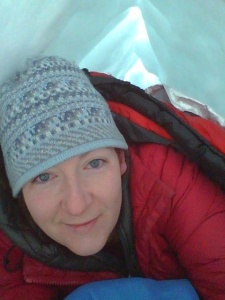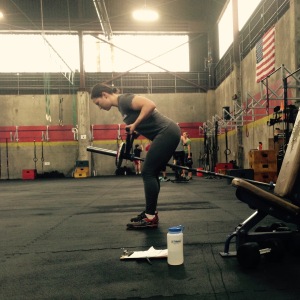Good god. Where to start?
After I sprained my ankle and we found out that it was, indeed, enough of a thing that I had to stay mostly off it for a few weeks, the Denali Girls decided as a team that rather than all heading down to Rainier together on Saturday and Sunday of this past weekend, we would instead get up early as planned, meet at a coffeeshop to discuss the ramifications of my ankle injury, and then the other Girls would head off to Rainier to do a first planned overnight, and I would head off to figure out this whole “swimming” thing.
And so Saturday morning I woke at the wee hour of 5am to trek down to a Starbucks in Renton, where Leigh Ann, Carolyn, Jenn and I would talk it all through. I was worried the Girls would be more worried about me being able to hack it, after a month of not much activity, but we had a good conversation and came up with a bit of a plan (my end of said plan: more swimming) for how we’d continue to advance towards our training goals, and avoid having the Ankle of Gloom ruin all the fun this May.
After our meeting I gave the Girls a parting honk and cruised home to that first day of swimming I mentioned in my last post, and they rolled off toward Mt Rainier. Our plan for the weekend had always been to make it a bit of a gear shakedown weekend – we’ve been accumulating literal piles of expensive new gear – cozy down layers, technical equipment like trekking poles, ice axes, stoves and snow saws, and we had some decisions to make – decisions about which second tent we should take (we are already borrowing a first very bomber tent) and about the sleds – how does this sled stuff, work, anyway? We were going to go find out.
Secondary goals for the weekend were to have another good long conditioner, and to just plain old spend more time together – to create more of the kinds of bonds that take you through the moments in climbing that we describe as Type II Fun – the part of an adventure that is mostly fun when you’re laughing about it in a bar a few days later, and not in the moment where you’re dealing with it (I also recently heard this called “Pre-Joy” as opposed to the real deal – Actual Joy).

So: Gear test. Check. Gear decisions. Check. Yet another conditioner? All over it. Bonding. Yahoooo.
When the Girls left Starbucks without me, I had a mix of emotions. I was energized and grateful that the Ankle of Gloom wasn’t overly daunting for them, and I was full of excitement and the belief that this is a really, really great team. I wondered a little bit if it wasn’t maybe a good thing that I was being taken out of the picture for a little bit, as I had been the convener of the climb. Perhaps my absence would lead to everyone else getting to know each other a little bit better, without me there to talk everyone’s ears off…
And on the other hand, I was living a little bit in This-Sucks-ville, as here we were finally at our first overnight, and I wanted to test the tents…and try out the stove…and pull a sled…and just be out there. I wanted to go too!
Instead I headed off to the Y on Saturday and then again on Sunday, benefiting immensely from the time and guidance of a fellow climber and former swimmer and lifeguard who took the time to show me some techniques and acquaint me with a workout on Sunday morning, and returned from ‘Day 2 of Lap Swimming’ pretty pleased with life on Sunday (I even figured out the swim cap!) …until Paul called.

Me, totally stoked on the YMCA (and a lot of chlorine), until Paul called.
Jenn’s post did a great job of sharing the experiences of the Girls on Saturday, Sunday, and Monday – well, here’s how it went on my end.
First I should say, though, is that one of the reasons I like climbing with these ladies is that we don’t take stupid risks. Did you see Leigh Ann’s note about her helmet being her favorite piece of gear? We’re not mindless rule-followers, but we’re not stupid, either (word to your mother – not wearing a helmet is stupid). We take appropriate precautions, we plan well, and we play by the rules because they keep us safe. I’d love to say that I’m a balls-to-the-way wild-ass hipster climber, but really (you probably know this already) – I’m not. We’re smart, practical, driven women. We’ve got shit to do – we’re not interested in getting hurt, missing work, or messing around. We’re interested in climbing a mountain, standing on its summit, and returning to tell about it. Nothing too crazy here.
One of those rules we all normally play by, though, is the setting of an “overdue” time, and last weekend, we as a group – all four of us – completely overlooked it.
Given the way that Sunday and Monday went down, I’ve thought this over quite a bit, and I personally think the main mistake we made last weekend was to underestimate what it means to climb up to Camp Muir, the “basecamp” on Mt Rainier in winter. That whole winter part being the key.
Experienced climbers often climb Mt Rainier on a route called the DC Route (DC for Disappoinment Cleaver). The DC route is climbed in two or three days, and is widely considered the most basic (easiest) route to the mountain’s summit. You leave from a massively accessible parking lot and Visitors’ Center called Paradise (which is entirely un-Paradise-like in the way that it is absolteuly overrun by tourists on the summer days when we mostly climb), embarking on your climb from 5,400 ft. You hike up and up to Camp Muir, a bit of a (kinda vast) campsite, more or less, at 10,080 feet (on a 14,410 foot mountain, do recall). Camp Muir is used in our normal training months (more or less March through June, and/or beyond) as yet another conditioning hike to get ready for the climbing season – it’s kinda what we do for exercise, and just another way to workout. It’s “just Camp Muir.”

A wicked great image of the DC route can be found on highpressurephotography.com (except the turnaround below the summit was unique to that person’s climb – but look for Camp Muir in yellow)
So the girls went off to just go to Muir (in winter) as we had planned, with sleds and lots of lots of new (but technically tested) gear intended for weather much colder than anything they’d find on our “little” mountain.
And I didn’t really put much thought into it (besides occasional pings of jealousy when Saturday turned out to be a beautifully clear night…in the city) until Sunday morning, when Paul, a friend of ours and one of Jenn’s emergency contacts called, because another friend of Jenn’s had mistakenly believed that Jenn would be back Saturday night, and was growing concerned. I reassured Paul that the Girls had absolutely intended to be out overnight, and were equipped as such, and asked him to let Jenn’s other friend know, so she wouldn’t worry. But in the process, I suddenly realized that we hadn’t set an overdue time – a time when their emergency contacts would automatically initiate emergency protocols, so as to ensure they were ok.
A bit about how that works, for those who don’t know – first – climbing time and time of return is naturally fairly variable. The weather, the strength of the party, how a climber is feeling that day, if and what they drank the night before, and a whole slew of other factors can slow climbers down when they’re outdoors, and many times the most prescient thing for a slow party to do is to stay out an extra night, get a bit more sleep, or wait out a storm, and then head down when the climbers are more energized, the weather is better, or there’s more natural light to climb by. Because of that, many emergency contacts will be told to wait until somewhere in the vicinity of noon the day after a party is due back before initiating emergency procedures, because most of the time that group will trudge on out by itself, a bit wet, or with a sprained ankle in the midst, but none the worse for wear. So we normally give our emergency contacts a specific time at which “to worry,” when they should take action to make sure we’re ok, but are unlikely to accidentaly trigger, oh, I dunno, a full Search & Rescue response when the climbers in question are ok. 🙂
So on Sunday early afternoon, a bit after Paul’s call, and without having heard from the Girls when I expected, I was surprised at myself, and shot off a text to the Girls:
Hi ladies! Just wanted to text and make sure you got off Mt Rainier ok! Hope you had fun – please let me know if you are out/down – I got a concerned call from Ms Carter’s eastside crew today because they didn’t know you were staying out overnight! 😛 (you so busted) 🙂
The ladies had planned on being back to Leigh Ann’s truck at Paradise by about 11:15, which we had discussed in advance, so that they could be back to the Park & Ride by 1:45pm, so that Jenn could be at work by 3pm – for which she’d mentioned she couldn’t be late.
At 1pm when I sent my text, I wasn’t that worried. Paradise has notoriously spotty cell coverage, and I figured if the Girls got out late they wouldn’t stop to send text messages, but would drive straight back to Renton to get Jenn on her way. I was mostly annoyed at myself for not having thought to ask more about their “worry time.”
After I didn’t hear back from the Girls by 2pm I began to assume they were delayed, and I realized that if I didn’t hear from them in the next few hours, it would mean they were spending the night on the mountain, because it gets dark at about 5:30 right now. Paul and I were in periodic and increasingly frequent text and phone contact, comparing notes on what we thought the story might be, and as the afternoon wore on I slowly began to be a bit more concerned about the team. I ran through their gear in my head: super bomber (very warm) sleeping bags and parkas, two 4-season tents, first aid gear because they’re all thorough like that, and a Denali-rated stove that I had personally tested in my driveway on Friday night before handing it off on Saturday morning. I didn’t really need to be worried, and I mostly wasn’t, yet.
The thing about worry (which I just explained to my still-concerned mother tonight), is that it’s contagious. When someone asks “Are you worried?” it seems to trigger more concern. Having climbed fairly extensively with Leigh Ann and a good bit with Carolyn, I know a lot about their decision-making, reaction to stressful situations, and tolerance for risk – in a vacuum, I wasn’t worried, and I probably wouldn’t have normally become so until heading to bed on Sunday night, because not having heard from them by bed on Sunday would mean needing to watch carefully for a message or signal for them on Monday. But having someone else (who was themselves concerned) ask the question, begged another: should I be?
And so I gradually became increasingly worried over Sunday afternoon. We had known that the weather was going to get blustery Sunday afternoon, but we’d assumed the Girls would definitely be off the mountain and back in Seattle by then – we didn’t even come up with a contingency plan for if they did get stuck, because (say it with me now) it was just Camp Muir. The forecast for Saturday called for new precipitation (several inches of snow) and blowing winds which could get up to 40-50 mph, up high. I’ve slept out in 30+ mph winds, and they’re loud, and feel violent, and eat lower quality 3-season tents for breakfast. So as everyone around me watched the Superbowl, I periodically checked my phone, and when no messages appeared, I became more worried.
Before the game started, Paul, myself, and Bree, Jenn’s primary emergency contact, had decided on a bit of a gameplan for what to do if we didn’t hear from the Girls as the hours passed. We knew our friends well enough that we felt confident they wouldn’t walk out mostly in the dark – for a little while, yes, but not at, say, 10 at night. So if we didn’t hear from them at 6 or 7 or so, we’d know they were overnighting, and would have a decision to make about whether to call the Park and let the staff there know that the ladies were overdue, or to wait till Monday morning, see if they walked out, and if not, then make the call. There are upsides and downsides to each option – the downside to calling on Sunday night was that it was really too early to call, given typical climbing conventions (that next day walk-out possibility) but then again, if the ladies hadn’t walked out already then Jenn was missing work at a job she loves, and nobody thought she’d be ok with doing that unless she absolutely had to – so were they all ok? The upside to calling was that Jenn was missing work, so we knew she was at least a little bit stuck in some way, and that if we called on Sunday night the Park would have more time to come up with a better plan in case a rescue really was needed, and they’d be ready to go sooner. Plus with that weather coming in…
It would be tedious to even begin to try to recount how 4 to 6pm on Sunday played out, but it would be accurate to say it was completely surreal. As the one person who knew everyone involved, their plan, and all of their emergency contacts (plus their gear and had a sense for their decision-making), a lot of the decision-making ultimately fell to me. Checking now, my phone records show that I made my first call to Leigh Ann’s emergency contact at 4:17pm on Sunday (as I watched the sky grow dark through the windows – that I clearly remember), that I followed it up with calls to Jenn’s emergency contact Bree, to Paul, then back to Bree, and so on, until we finally had a sense for a bit of a decision to call the Park, and I tracked down a phone number for and called Carolyn’s partner Jack at 5:57pm, explained the situation (which he, as a climber, had already anticipated) and he agreed that given the forecast, it might be appropriate to call the Park. In that window, between 4:17 and 6:06, I made and received twenty-five phone calls to four people, not counting the calls I made to the Girls themselves.
And so it happened that at a few minutes after 6, as the house at which I was a guest roared with the ebbs and flows of the Superbowl, I called 911, and asked to be connected to the Mt Rainier Ranger Station, because I wanted to report a climbing party that was overdue.





